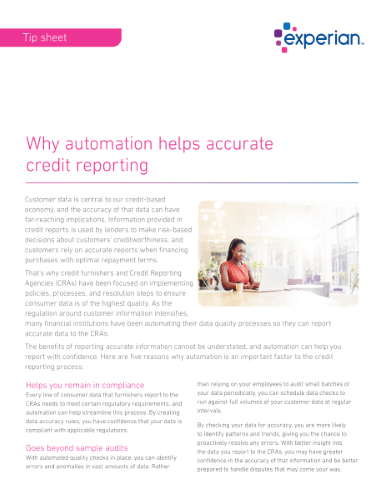- Products

Enjoy a free 30-day trial of our
data validation software.Experience the power of trusted data
solutions today, no credit card required! - Solutions

Enjoy a free 30-day trial of our
data validation software.Experience the power of trusted data
solutions today, no credit card required! - Partners

Enjoy a free 30-day trial of our
data validation software.Experience the power of trusted data
solutions today, no credit card required! - Learn more
- Pricing
- Contact Us
Why automation helps accurate credit reporting
Customer data is central to our credit-based economy, and the accuracy of that data can have far-reaching implications. Information provided in credit reports is used by lenders to make risk-based decisions about customers’ creditworthiness, and customers rely on accurate reports when financing purchases with optimal repayment terms.
That’s why credit furnishers and Credit Reporting Agencies (CRAs) have been focused on implementing policies, processes, and resolution steps to ensure consumer data is of the highest quality. As the regulation around customer information intensifies, many financial institutions have been automating their data quality processes so they can report accurate data to the CRAs.
The benefits of reporting accurate information cannot be understated, and automation can help you report with confidence. Here are five reasons why automation is an important factor to the credit reporting process:
Helps you remain in compliance
Every line of consumer data that furnishers report to the CRAs needs to meet certain regulatory requirements, and automation can help streamline this process. By creating data accuracy rules, you have confidence that your data is compliant with applicable regulations.
Goes beyond sample audits
With automated quality checks in place, you can identify errors and anomalies in vast amounts of data. Rather than relying on your employees to audit small batches of your data periodically, you can schedule data checks to run against full volumes of your customer data at regular intervals.
By checking your data for accuracy, you are more likely to identify patterns and trends, giving you the chance to proactively resolve any errors. With better insight into the data you report to the CRAs, you may have greater confidence in the accuracy of that information and be better prepared to handle disputes that may come your way.
Monitors your customer data around the clock
Wouldn’t it be nice to have a visual to see the accuracy of your consumer data in real time? With automated data quality processes, that’s easy to do. Once you’ve programmed data quality checks to run automatically, you can begin to build dashboards and reports that update using the latest data.
Further, by setting data quality thresholds, you can help ensure that the accuracy of your information remains at an acceptable level and get notified when too many errors are caught by the system. Day or night, automated data quality checks can help give you better visibility into the accuracy of your credit files.
Helps boost employee productivity
With less time spent manually auditing consumer data, your employees could have more time to focus on resolving potentially inaccurate information before it is sent to the CRAs. This data can be maintained in your systems to help you to investigate and resolve consumer disputes should they arise in the future. By empowering your employees with complete records, they have the chance to work more efficiently and to assist better service to customers who have filed a dispute, leading to better customer outcomes and continued loyalty.
Helps reduce costs related to fines and inefficiencies
Automating the quality checks around your data may help address fines that could come up from noncompliance. Further, because many regulations require data furnishers to establish clearly defined policies and procedures around the consumer data they report the CRAs, you can be a step closer to meeting regulatory obligations.
Automating your credit reporting can help create efficiencies across your institution. Learn how you can automate your reporting.
